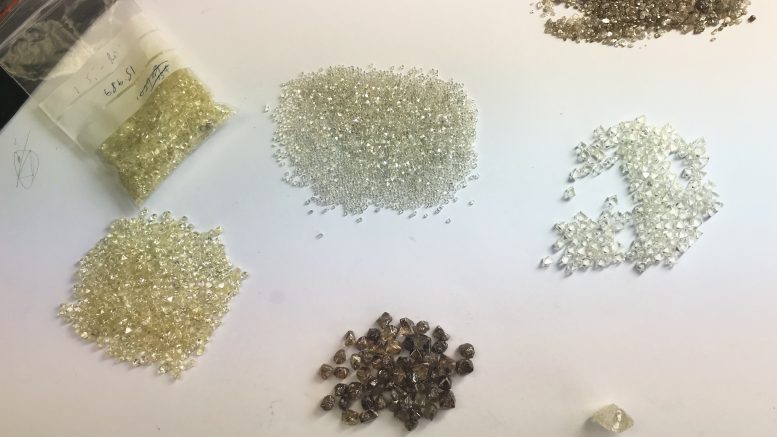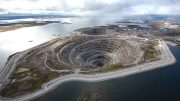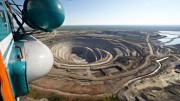Global diamond production in 2020 fell by more than 20% to about 113 million carats due to planned production declines by the major producers and pandemic-related suspensions and curtailments. The Northern Miner recently caught up with Paul Zimnisky, an independent diamond analyst and consultant in New York to hear what he thinks lies in store for the sector over the next five years.
The Northern Miner: In December you forecast that global diamond production will remain well-off until at least 2025, after the most recent high-water mark reached in 2017 of 152 million carats. Has anything changed since then to alter that view?
Paul Zimnisky: This is still my view. I think it is important to note that almost all of the operations that were interrupted due to the pandemic last year have restarted or are expected to restart soon, but global output is still expected to be at multi-years lows for the next few years as legacy mines reach depletion and very few new mines commence production. That said, the two majors are currently guiding production at what I estimate to be below capacity levels, so I see the biggest risk to my forecast being majors raising production levels closer to capacity; however, even if this happens I estimate that we will still be well below 2017 levels.
TNM: How would you characterize consumer demand for diamonds last year and what are your forecasts for 2021-2025?
PZ: I think it’s fair to say that material luxury outperformed experiential luxury given all of the travel restrictions and large group gathering restrictions globally last year. As far as diamond jewelry versus other material luxury options, jewelry was the second-best performing category for LVMH in calendar Q4, and they are the largest luxury company in the world. Jewelry was the overall best performing category for Richemont, the second largest luxury company in world. There are other similar data points as well. So, in general, jewelry had a pretty good 2020 and the momentum accelerated into year-end and the holiday season and seems to be continuing into 2021.
That said, I estimate that global diamond jewelry demand was still down 20% or so last year compared to 2019. I am forecasting that we will get back to pre-pandemic levels by 2022, with a return to more normal growth for the industry, of low-to-mid single digit percentages, thereafter. Of course, there are a lot of moving parts right now with regards to the vaccine rollout, the global “re-opening” and subsequent consumer sentiment. But, if everything lines up, we could actually be setting up for a generational consumer boom in the coming years due to pent-up demand combined with all of the stimulus that is working its way through the global financial system right now –so that’s the upside. More specific to diamonds, right now, the hotel and leisure industry consensus is that wedding demand is crazy strong for the second half of this year, so going to be interesting. My worry is that all of this stimulus could lead to a boom-bust situation in the coming years.
TNM: You’ve said that an oversupplied market has been “the greatest plague” to the diamond industry for most of the last decade. What caused that and what is the situation now? Is it getting better?

Paul Zimnisky at a Northern Miner event in 2019. Credit: George Matthew Photography.
PZ: I think you have to go back to 2011 to really analyze this. Prices made an all-time high back then, and that encouraged a wave of new diamond exploration and development which resulted in a significant amount of new supply coming to market towards the end of the decade. This combined with over-speculation with regards to inventory accumulation by some in the manufacturing segment and of course the emergence of much more affordable and widely available man-made diamonds is what in my opinion led to an oversupplied diamond pipeline which has hindered the industry in recent years. But in a way it’s a self-correcting cycle, if you will; multiple years of weaker prices have resulted in very little new diamond mine development. So now the industry is actually seeing the opposite effect of what appears to be an undersupplied market in some cases. All in all, from a supply standpoint, I think the industry right now is the best positioned it has been in quite some time.
TNM: Do you see the need for more consolidation in the diamond sector?
PZ: The consolidation seems to be happening at the mid-stream and down-stream segments of the industry, where for example, smaller, low-margin diamond polishers are losing out to more formal, larger, corporate types of manufacturers. Downstream at retail, more modern jewelers with reliable eCommerce and digital functionality are taking market share from less digitally equipped traditional jewelers. This has been greatly accelerated by the pandemic.
TNM: Which companies are leading the way in bringing in greater business discipline?
PZ: It appears that greater business discipline, as far as inventory management, has begun to take hold in both the upstream and mid-stream segments of the industry. The two major diamond miners have reduced production guidance and have provided unprecedented flexibility with their contracted rough diamond buyers; in addition, and more specifically, De Beers has recently taken structural steps to more efficiently allocate rough to its buyers which should keep supply in the hands of the strongest players, those that can profitably add-value to it. In addition, the mid-stream industry has also taken measured action to encourage more conservative practices which was seen following the onset of the pandemic. For example, Indian diamond manufacturing trade organizations called for a voluntary import ban on rough diamonds last year in an effort to sustain manageable levels of inventory aimed at supporting polished prices and preserving the creditworthiness of the industry.
TNM: What are some of the key things you’d like to see change amongst the diamond producers?
PZ: I would really like to see the diamond industry be a leader in the area of sustainability. Apart from simply being the right thing to do for future generations, from strictly a business standpoint, I think a robust approach to sustainably is actually a necessity for the industry given that diamonds are a discretionary item that appeal to consumers emotions. The product has to have a positive association with people and make consumers feel good.
TNM: What does the industry need to do to be more sustainable?
PZ: In terms of mining, the diamond industry is uniquely positioned given that most diamonds are found in kimberlite rock, and as I am sure most of your readers know, kimberlite is an ultramafic rock, which represents a relatively small percentage of the accessible rock on the planet. Ultramafic rocks are unique in their ability to naturally absorb very high concentrations of CO2 from the atmosphere. So, I think you can see where this is going.
TNM: De Beers has been working on a kimberlite carbon capture initiative for about five years. Can you tell us a little bit about that?
PZ: It relates to the idea of using kimberlite tailings for “mineral carbonation” as I just described. De Beers has been co-developing a related technology for a few years now, so I expect to be hearing more about this going forward. I think this is one of the most exciting developments in sustainability, and not just for the diamond mining industry but for the larger mining industry as a whole, as this could potentially result in not only carbon neutral mining but net-negative carbon mining.
TNM: Diamond provenance initiatives will become more and more important to consumers. What are the current capabilities in the sector to track provenance and are there enough new technologies out there that can help? And when do you think tracking for all producers will become mainstream?
PZ: Good question, I think this is one of the most important developments in the industry right now for sure. In the coming years when a customer buys a diamond I think they will be provided with the source provenance of the diamond, for example, the country where the diamond was mined or even the specific mine, in addition to the traditional quality characteristics provided with a grading report, like the 4 C’s. Diamond provenance initiatives have become a priority in the industry, boosted by the availability of new technologies that makes verifiable tracking of a diamond through the, sometimes convoluted, supply chain a reality. I think this is such an important initiative because geological provenance data of a diamond increases its “story telling” appeal, but perhaps more importantly, it also communicates to the consumer that it is a real, natural diamond that is conflict-free. I think this along with sustainability initiatives, like the carbon capture technology, goes a long way in more aligning the industry with where we are moving as a society.






Be the first to comment on "Pent-up weddings and stimulus could mean ‘generational consumer boom’ for diamonds"